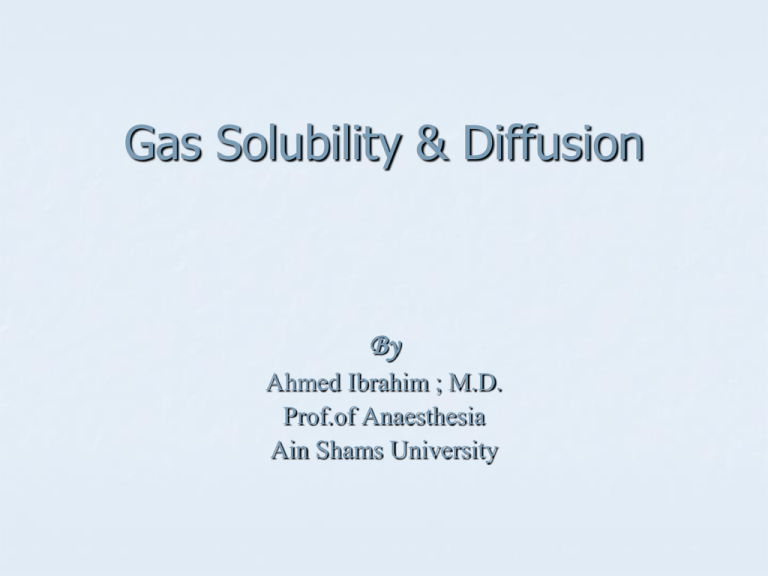Solubility Diffusion
advertisement

Gas Solubility & Diffusion
By
Ahmed Ibrahim ; M.D.
Prof.of Anaesthesia
Ain Shams University
solubility of gases in liquids
Amount of a gas dissolved in a liquid
depends on:
Gas nature
Liquid nature
Liquid temperature
Gas pressure above liquid
1 / Solubility
Solubility Pressure
“ at constant temperature , AMOUNT of a given gas dissolved in a given
liquid partial pressure of the gas in equilibrium with that liquid “
Henry’s Law
volume of Gas dissolved in unit volume of Liquid
(at certain temperature & pressure)
Solubility Coefficient
Gas volume is stated at
certain temperature
VT
V
Pressure independent
Ostwald ()
V
V
Gas volume is
corrected to STP
V0
V
Bunsen ()
Ostwald = Bunsen + { Bunsen x temp }
273
how a gas divides itself between two
phases
1L N2O
37oC
1L blood
( 0.47 L N2O)
Partition Coefficient
ll
ratio between the amount of gas in one phase , compared with other at:
•Equal volumes
•Equilibrium in both phases
•Certain temperature
•Phases in order
Bood / Gas = 0.47
Gas / Blood = 1 / 0.47 = 2.1
Partition coefficient
ll
Solubility coefficient
Temperature dependant
Pressure independent
2 differences
order of phases should
be stated
Partition coefficient can be
applied to 2 liquids
(always liquid /gas in Ostwald)
N2O Blood/Oil = 0.47/1.4= 0.33
*For anaesthetic agent , the more it is soluble in blood (higher B/G coefficient)
slow equilibrium with blood
slower induction (vice versa)
Blood:Gas Solubility Co-efficient
Desflurane
0.42
Nitrous Oxide
0.47
Sevoflurane
0.6
Isoflurane
1.4
Enflurane
1.9
Halothane
2.3
Diethyl Ether
12.1
*Oil/Gas
The more oil/gas
reflects potency (MAC) of inhalation anaesthetic
more potency (less MAC)
Gas diffusion through porous membranes
P
Gas transfer in lungs
Diffusion oxygenation
Membrane oxygenator
P
Rate of diffusion
Diffusion Rate V
T
Diffusion Rate =
Constant =
pressure difference ( Ficks’ law)
solubility
surface area
1/ molecular weight (Graham’s law)
1/ membrane thickness
P. diff x Solubility x surface area
molecular weight x thickness
constant x pressure diff.
Diffusion Rate
pressure diff.
= Diffusion Capacity
Diffusion capacity : rate of gas transfer in ml/min/mmHg
Diffusion capacity for lung for O2 =
O2 uptake
PA-P O2
= 21 ml/min/mmHg (adult at rest)
For CO2
Mol wt
PA-P gradient
B/G coeff.
O2
CO2
32
44
~60 mmHg
~6 mmHg
0.023
0.49
Diffusion capacity of lungs for CO2 is 20 times that for O2
(alveolo-capillary membrane is a wet membrane)
O2 B/G partition coefficient = 0.023 (37oC)
1 liter blood contains 0.023 Liter = 23 ml O2
100 ml blood contains 2.3 ml O2 ( at 760 mmHg )
For each mmHg , every 100 ml blood contains 23 = 0.003 ml O2
10x760
If at equilibrium between blood and alveolar air (breathing air) ,
PaO2 = 100 mmHg
At tension of 100 mmHg , 100 ml blood contain 0.3 ml O2 dissolved
O2 content of arterial blood = (Hb% x sat x1.34) + (PaO2x0.003)
on breathing air , PAO2 ~ 100 mmHg
PAO2 = PIO2 – PACO2
RQ
PAO2 = { FIO2 x ( PB - PH2O) } - PACO2
RQ
•PH2O : SVP of H2O at body temp.
•RQ : Respiratory Quotient
B/G coeff (37oC):
N2
O2
N2O
CO2
0.015
0.023
0.47
0.49
•Diffusion oxygenation
•Diffusion hypoxia
•2nd gas effect
•Body air spaces
Body air spaces: N2O diffuses in and out of air spaces faster than
N2. Air filled spaces expand in the presence of N2O e.g. bowel,
pneumothorax
Diffusion hypoxia: when one turns off N2O at the end of
anaesthesia, its concentration in the alveoli becomes lower than in the
blood. Consequently N2O floods in from the blood, diluting the alveolar
gases and the patient breathes in a hypoxic mixture. To overcome this,
one should administer 100% O2 to the patient until the N2O washes out.
2nd gas effect (concentration effect) : occurs when N2O is the
second gas used for anaesthesia. Even though N2O is highly insoluble in
blood - as an anaesthetic agent- it is much more soluble than O2 and N2.
Its rapid absorption from the alveoli causes a sharp rise in the
concentration of the other inhalational agent.











